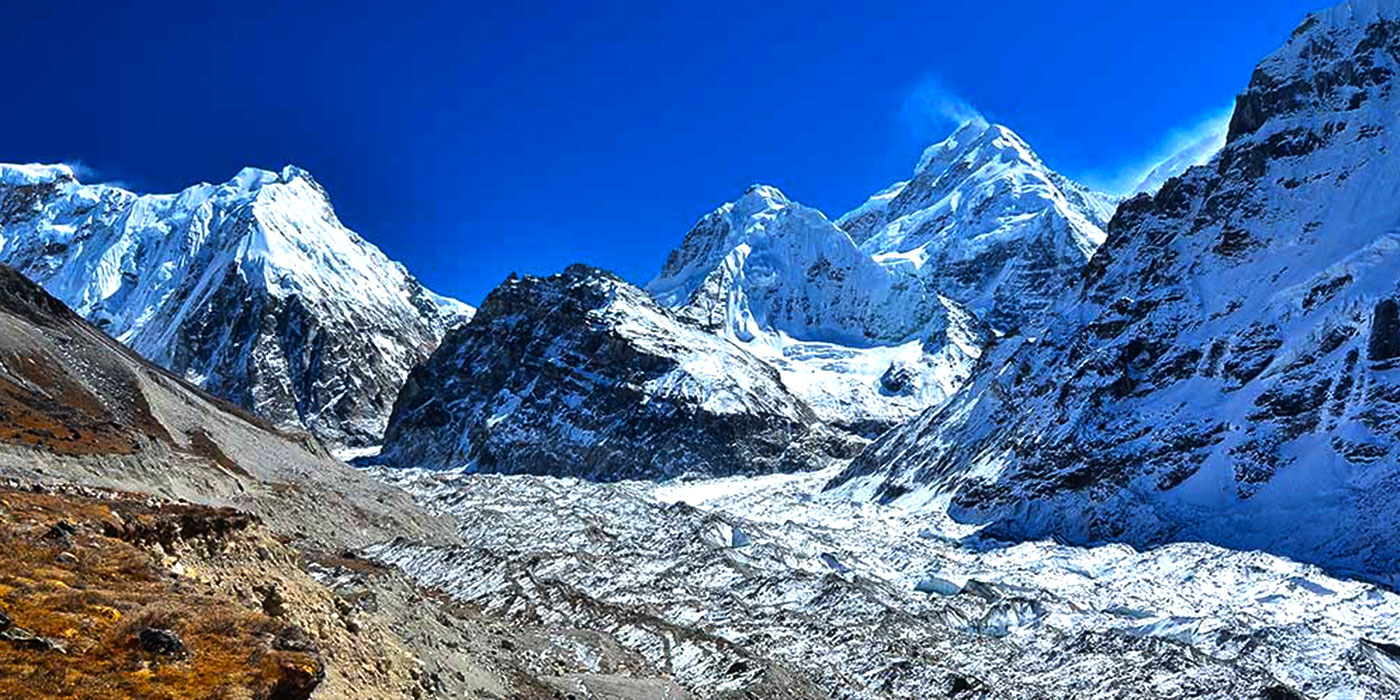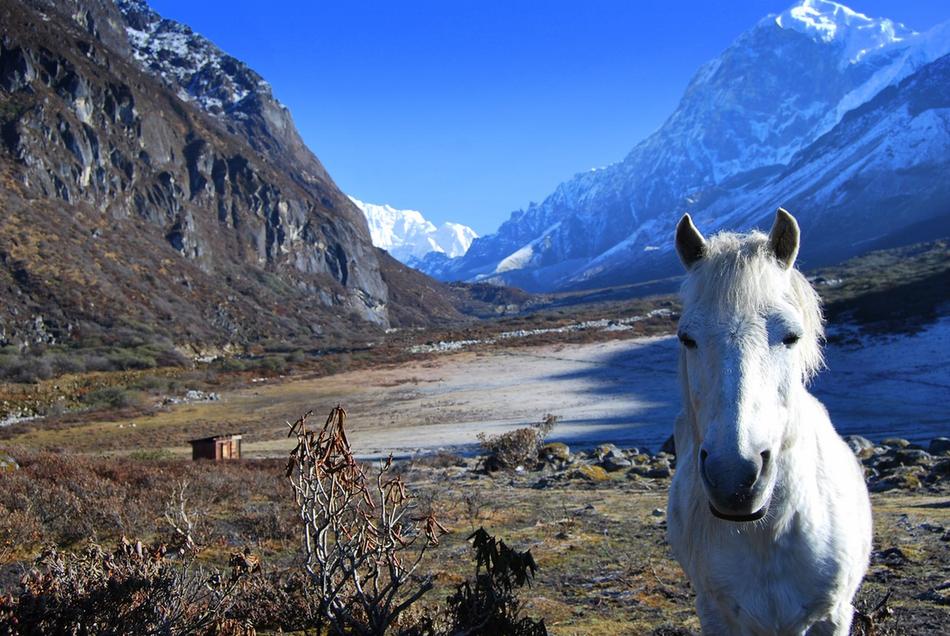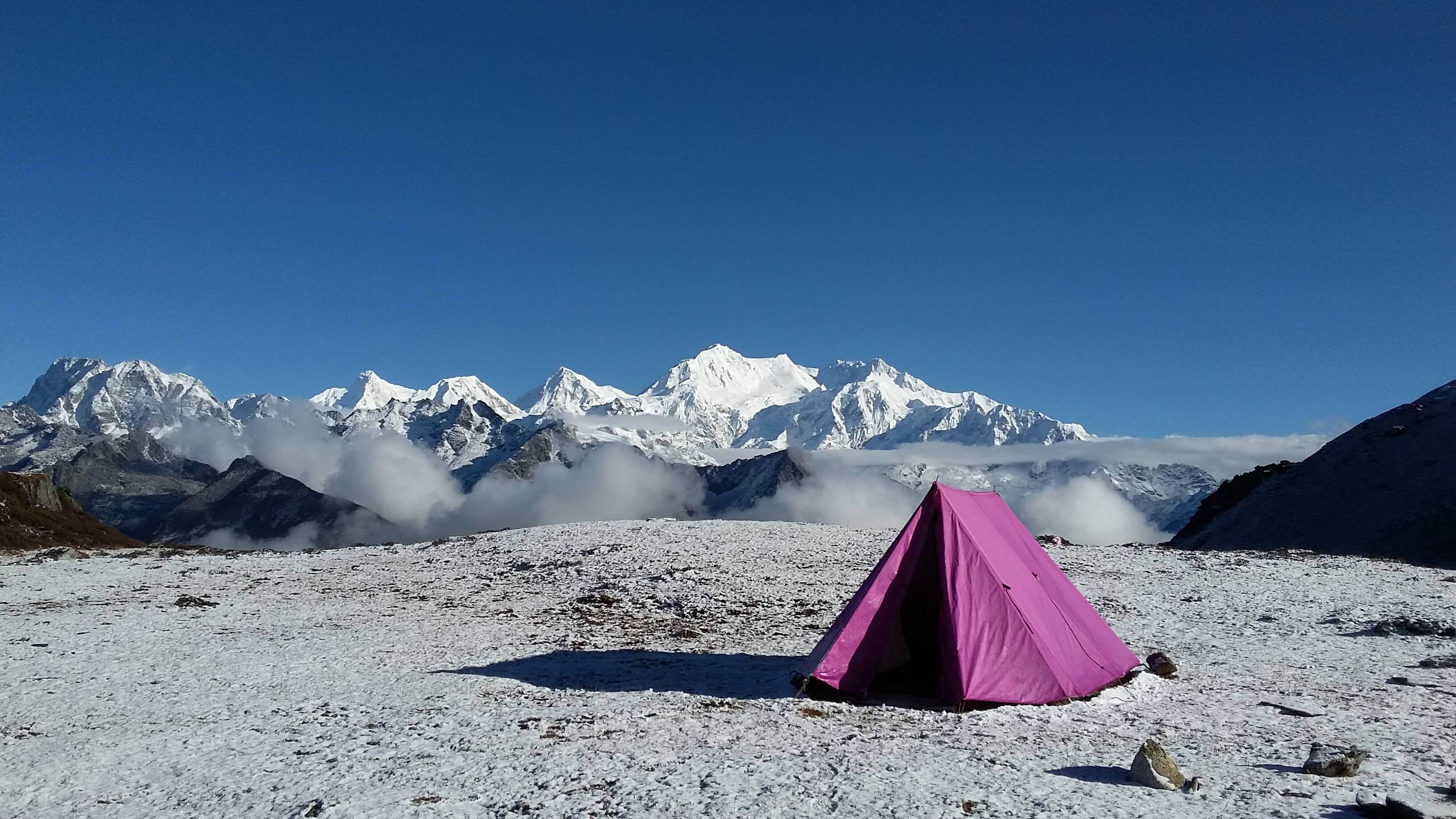Trip Overview
Sikkim - Darjeeling Kanchenjunga Trek is a famous long high altitude trek route that offers an exciting opportunity to adventure lovers to explore the Kanchenjunga mountain range from both Sikkim and Darjeeling side.
Sikkim Darjeeling Kanchenjunga Trek is a beautiful combination of the famous Goechala and Sahdhakpu Trek. During this trek, you will be able to witness the breath-taking views and charm of the Kanchenjunga and Singalila mountain range from two different locations and angles.
Mt. Kanchenjunga, Mt. Everest, Mt. Lhotse, Mt. Makalu, Mt Pandim, and several other towering snow-capped mountain peaks are seen during this Trek. Famous Sleeping Buddha sight of the Kanchenjunga mountain range is also seen during this Trek.
This trek is best suited for adventure lovers and nature seekers who wish to spend a longer period with pristine nature.
Trip Highlights
1) Darjeeling - A hill Town often regarded as the Queen of the Hills due to its serene and Natural Beauty. Darjeeling is surrounded by emerald-green tea plantations with a backdrop of jagged white Himalayan peaks. Darjeeling is a Colonial British Town. Darjeeling Tea is famous all over the world.
2) Maney Bhanjyang - Located at 2150m is a starting point for the trek to Sandhakpu and a gateway to Singalila National Park. Maney Bhanjyang lies on the border between India and Nepal.
3) Sandhakpu - At an altitude of 3636m Sandhakpu is an ideal viewpoint for the view of Mt. Everest, Mt. Makalu, Mt. Lhotse, and Mt. Kanchendzonga. Sandhakpu is situated at the edge of Singalila National Park.
4) Yuksam - The first capital of Sikkim and a base camp of famous Goechala Kanchendzonga Trek and several Mountain Expeditions. The Oldest monastery of Sikkim, Dubdi Monastery is located at Yuksam. The Famous Coronation Throne where the first king of Sikkim was crowned by the three religious monks is in Yuksam.
5) Tshoka - A small Refuge settlement at the height of 3000m. A first-day camping point of the trek. From Tshoka one can see a glimpse of towering snow-capped mountain peaks - Mt. Pandim and a few others.
6) Dzongri Viewpoint - The most beautiful and ideal viewpoint of high-altitude treks in Sikkim. One can witness a 360-degree view of the Pristine and Panoramic 16 snow-capped mountain peaks and hills. Located at the height of 4250m Dzongri Viewpoint offers sublime and capitative scenery of the entire Himalayan range...
7) Goechala Viewpoint - The closest point to Mt. Kanchendzonga - The guardian deity of Sikkim! The Goechala viewpoint provides a sublime and closest view of Mt. Kanchendzonga and Mt. Pandim. One can have the closest look at Thalung Glacier too at the bottom of Mt. Kanchendzonga.
8) Samiti lake - One of the most pristine and holy high-altitude lakes in Sikkim. It lies exactly Infront of Mt. Kanchendzonga and is a treat to witness on a clear sunny day.
9) Laxmi Pokhari (Lake) in Dzongri - A pristine high-altitude lake situated 3-hour walk from the Dzongri Campsite
Health and Fitness
You have to be Relatively Fit and Healthy to undertake the Sikkim Darjeeling Kanchenjunga trek. Trekking for 6 to 8 hours a day is one of the most important requirements for this high-altitude trek. Apart from good health condition basic mental preparation is also very important to undertake this Trek.
People suffering from Acute Heart and Lung diseases, Asthma, and High blood pressure are not recommended to take up this trek.
To complete this high-altitude trek regular exercises like running, skipping, aerobics, Zumba, and long-distance uphill trekking (4 to 5 times a week) are highly recommended. One should start making basic physical preparation at least a month before a trek. These exercises help you during the Trek.
The packing of right and comfortable clothing also makes a difference in the completion of Trek, so it is necessary to be disciplined while packing your clothing for the trip. You can contact us for help with clothing choice and packing!
During the Trek, we provide a basic medicine Kit which includes Medicine for High Altitude sickness, Headache, Diarrhoea, Vomiting, Common Cold, etc. All of our medicine is scientific medicine purchased in India, however, we advised you to bring your small medicinal kit for the trip if possible.
Trekking/Tour Tips
1. A common tendency among young blood and beginners is to show enthusiasm by walking fast with excitement. Even the experienced sometimes try to show off by walking fast, this is soon exhausting and not recommended. Walk slow - warm up gradually and continue at a slow comfortable pace before pushing yourself a little more.
2. Develop a personal rhythm. Maintain your steps to synchronized with breathing. This will help minimize getting out of breath.
3. Walking in Himalayan trails with loose soil and rocks is tricky. So, avoid stepping on loose soil and rocks and place the foot flat and firm with a better grip. Always follow the rule ‘heel first’ while walking in the Himalaya trail.
4. Walking in a zigzags manner while ascending on a very steep slope is advisable. While descending walking zigzag is a good technique to avoid excessive pressure on knees and avoid knee pain and blisters.
5. Avoid stepping on loose stones and soil to avoid an accident.
6. Avoid overtaking fellow travelers on a narrow trail. Only Overtake at comfortable wide space if necessary.
7. While ascending and descending a slope or over loose stones, leave sufficient space between the next person so that any stone rolling down does not hit trekkers below.
8. Do not run down a slope. Bend knees a little while descending. Dig heels into soft snow or soft ground.
9. Our Himalayan condition is mostly wet so avoid wet grass, wet roots, and the muddy zone which can be very slippery. Be careful while walking on them.
10. Shortcuts on a foot trail should be avoided.
11. Always put-on warm clothing while taking a rest. This will help avoid getting cold, cough and high-altitude sickness
12. Respect the sentiments and traditions of the local hill people.
13. Always carry enough water in your water bottle as water is essential in avoiding altitude sickness.
14. Wear a comfortable and right set of trekking boots, pants, and jackets. Avoid wearing new trekking boots directly for the Trek. Get used to it by wearing it before the trek. Carry all necessary clothing.
Halts and Rests:
1. While taking a rest, lie against a tree trunk, a big stone, or on flat ground. Place your legs on your bags or any other higher ground. This helps regulate blood circulation.
2. Stop at any comfortable point after the first start to readjust your rucksack, jackets, or to tie a shoelace for better comfort and adjustment.
3. Do not make frequent or prolonged halts. Too many small stops destroy the walking rhythm. Frequent rests are not helpful. You should follow your own rhythmic walking pace and technique to avoid unnecessary tiredness. A stop should be made only at natural stopping points, like on the top of a ridge, or before an ascent, or at a scenic viewpoint.
4. Stop and place yourself on the safer (Mountain) side to give way for the pack animals to pass through. Avoid bags carried by the animals that can push you. Be aware of the yak's horn too.
FAQ (Frequently Asked Questions)
HOW TO REACH DARJEELING & YUKSAM?
The closest Airport to both Darjeeling and Yuksam is BAGDOGRA AIRPORT. Sikkim also has its own new Airport at Pakyong. You have to fly to Bagdogra Airport to reach Darjeeling and you can fly either to Bagdogra Airport or Pakyong Airport to reach Yuksam. Darjeeling is 3 to 4 hours drive from Bagdogra Airport. Yuksam is 6 hours drive from Pakyong and a 7 to 8 hours drive from Bagdogra Airport.
WHAT GEARS AND CLOTHING TO CARRY FOR SIKKIM DARJEELING KANCHENDZONGA TREK?
No matter what season you are planning for the mountains are always going to be cold, rough, and tough so it is absolutely necessary to pack yourself with adequate and proper clothing. Here is the standard kit checklist for the Sikkim Darjeeling Kanchendzonga Trek.
Proper packing of the trekking gears is absolutely necessary with eyes on the weight limit. It is important to have a good brand of clothing.
Basic Gears:
Back Pack & rain cover or Duffel bag (50 to 70 ltr)
Day Pack & rain cover (20 to 30 ltr)
Walking stick (1 pair or at least one)
Water Bottle (2 bottles of 2 ltr each)
Thermos flask (1 nos)
Head Light (1 Nos with 4 pairs of batteries)
Gaiters (1 pair)
Upper and Lower Clothings:
T - Shirt (2 to 3 full sleeves). Mostly noncotton
Fleece T-shirt (1 nos)
Thermal Inner-wears or base layers (1 nos or 1 pair) such as long jones
Fleece Jacket (1 nos)
Down, Feather, or Holofil Jackets (1 nos)
Wind and Waterproof jackets & pants (1 pair)
Trekking Pants (1 pair). Comfortable and durable
Short Trekking Pants (1 nos or 1 pair)
Poncho (1 nos)
Headgears:
Woolen cap (1 nos)
Sun cap (1 nos)
Balaclava or scarf (1 nos)
Sunglasses (1 nos) U/V protected and dark
Hand gears:
Waterproof gloves (1 nos)
Woolen gloves (1 nos)
Feet gears:
Waterproof Trekking boots (1 nos) preferably ankle high Goretex, North face, Colombia or Quechua
Snickers or running shoes (1 nos) preferably from any reputed brand
Gaiters (1 nos)
Sandals or flippers (1 nos)
Cotton socks (4 pairs)
Woolen socks (2 pairs)
Personal utilities:
Sunscreen cream
Moisturizers
Hand sanitizers
Toilet papers and wipes
Anti-bacterial powders
Lip balm
Toothbrush and toothpaste
Proper packing of the trekking gears is absolutely necessary with eyes on the weight limit. It is important to have a good brand of clothing.
CAN I EXIT YUKSAM ON THE LAST DAY OF THE TREK DIRECTLY?
Yes, you can if you are looking to reach any other location near to Yuksam OR if it is too urgent and necessary. Driving to Airport and Railway directly after the trek is not recommended.
We will advise not to plan to leave Yuksam directly after the last day of Trek as it will be too tiring and hectic. Driving at night on the Himalayan road is not comfortable and enjoyable.
The earliest you will reach Yuksam on the last day of the trek is around 1 pm so long hours drive thereafter is not possible.
CAN I LEAVE EXTRA BAGS AT YUKSAM AND COLLECT THEM ON THE LAST DAY OF THE TREK?
Yes, you can keep a bag of clothes at Yuksam and collect it after the trek. In fact, we will advise you to leave one set of clothing at Yuksam for the last day as normally pack animals arrive late on the last day of the trek.
You can even keep valuables and cash at our office safely and collect them after the trek.
WHAT DOCUMENTS NEED TO BE CARRIED?
It is mandatory for Indian trekkers to carry identification documents such as VOTER ID CARRD, DRIVING LICENSE, AADHAR CARD, INDIAN PASSPORT. Original documents need to be carried along with 4 pcs PASSPORT SIZE photograph.
Foreigners need to carry INDIAN VISA, PASSPORT & SIKKIM INNER LINE PERMIT along with 4 pcs PASSPORT SIZE photographs.
A medical fitness certificate is also mandatory however this can also be arranged at Yuksam in case you are not able to bring it.
IS THERE CONNECTIVITY DURING THE TREK?
There is no phone connectivity during the Sikkim Darjeeling Kanchendzonga trek. Darjeeling, Maneybhanjyang and Yuksam is the last village where you can get a phone and internet connection.
At certain specific locations between Maneybhanjyang to Chitre, Yuksam to Tshoka, you can get Vodafone, Airtel, and Jio networks. Even at Tshoka and Phedang, you can get a phone network if the weather condition is favorable.
There is no electricity throughout the Sikkim Darjeeling Kanchendzonga trek once you cross Maneybhanjyang and Yuksam. In Sandhakphu side trek you have solar lights at tea houses and lodges.
HOW IS THE WEATHER & TEMPERATURE DURING THE TREK?
There are two distinct seasons for doing Sikkim Darjeeling Kanchendzonga Trek. Mid-March, April to May (Spring) and Mid-September, October to November (Autumn). Normally weather remains good and clear in those given periods however there is no guarantee as weather is extremely unpredictable in our Himalayas and does change within hours and days.
The temperature at each campsite depends largely on each day's specific weather condition.
Spring (Mid-March, April till May)
* Yuksam to Tshoka / Darjeeling to Maneybhanjyang
Morning and Evening – 12 to 16 degrees centigrade
Day time – 18 to 24 degrees centigrade
Late Evening and Mid Night – 8 to 14 degrees centigrade
* Phedang, Dzongri, and above / Tonglu, Tumling to Kali Pokhari and above
Morning and Evening – 4 to 12
Day time – 12 to 18 degrees centigrade
Late Evening and Mid Night – minus 10 to 4 degrees centigrade
Autumn (Mid-September, October till November)
* Yuksam to Tshoka / Darjeeling to Maneybhanjyang
Morning and Evening – 8 to 14 degrees centigrade
Day time – 16 to 21 degrees centigrade
Late Evening and Mid Night – 2 to 10 degrees centigrade
* Phedang, Dzongri, and above / Tonglu, Tumling to Kali Pokhari and above
Morning and Evening – minus 8 to 10
Day time – 2 to 14 degrees centigrade
Late Evening and Mid Night – minus 15 to 2 degrees centigrade













 Dear
Dear
 Dear
Dear Dear
Dear






